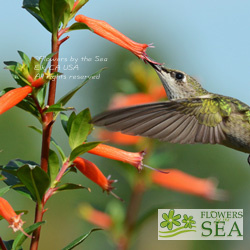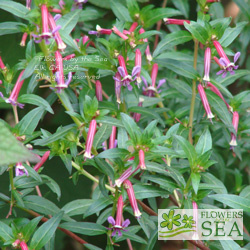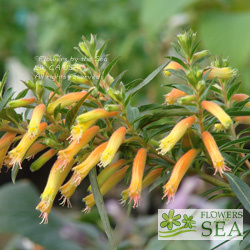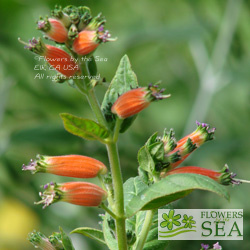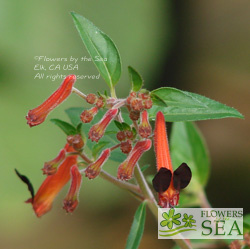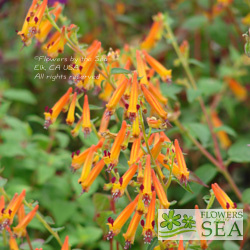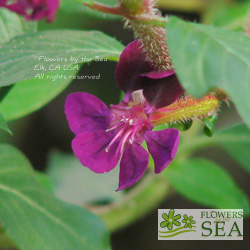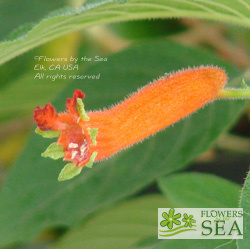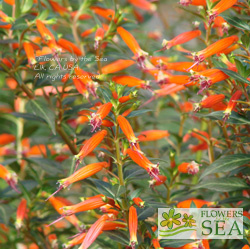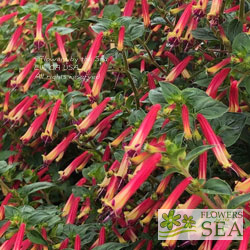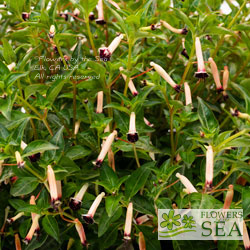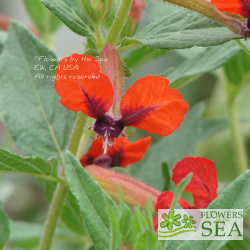Cuphea Picture Gallery
An abundance of colorful, tubular blossoms filled with nectar attract hummingbirds and butterflies to Cuphea flowers. They are easy grow perennials or annuals depending on where you live. Another benefit of Cuphea is that it is ideal for wildlife garden design and are particularly attractive to hummingbirds.
Some varieties of Cuphea have a cylindrical firecracker or cigar-like look without a corolla. Others, called bat face Cuphea, have minimal petals that look like tiny bat or mouse ears. FBTS grows many varieties, including Cuphea David Verity.
Cuphea flower colors include gold, lavender, orange, pink, purple, red, white and purples so dark that you might as well call them black. The green, ovate or lance-shaped foliage of the genus is veined and ranges from slickly smooth to hairy and sticky.
Related Blog entries for plants in the Cuphea Picture Gallery
Most bat faces only look beautiful to their mothers. However bat-faced Cuphea schumannii seems pretty as punch to hummingbirds in search of a sweet drink of nectar. If you take a close look at the ragged, open end of each flower, you'll see two, tiny, lavender petals standing straight up like bat or mouse ears. So, despite its common name, Orange Cigar Plant, this species is known as a bat-faced Cuphea. Aside from being excellent for attracting pollinators, Cupheas are becoming important agricultural crops that reduce pesticide use.
When massed in borders or standing out as a main attraction in a container planting, Cuphea x ‘David Verity’ is a visual feast for people as well as an actual feast for small wildlife. Rich in nectar, the plant’s dainty, cigar-shaped, orange-red flowers nestle amid a cloud of mid-green leaves shaped like tiny garden trowels.
| Name | Mature height | Mature width | Flower color | Bract color | Exposure |
|---|---|---|---|---|---|
| Cuphea x 'David Verity' | 3 to 4 feet | 3 to 4 feet | Not yet defined * | Not yet defined * | Full sun to partial shade |
| Cuphea x 'Kristen's Delight' | 3 to 4 feet | 3 to 4 feet | Not yet defined * | Not yet defined * | Full sun to partial shade |
| Cuphea micropetala | 1 to 2 feet | 2 to 3 feet | Not yet defined * | Not yet defined * | Full sun to partial shade |
| Cuphea schumannii | 3 to 4 feet | 3 to 4 feet | Not yet defined * | Not yet defined * | Full sun to partial shade |
| Cuphea 'Minnie Mouse' | 2 to 3 feet | 2 to 3 feet | Not yet defined * | Not yet defined * | Full sun to partial shade |
| Cuphea 'Strybing Sunset' | 2 to 3 feet | 2 to 3 feet | Not yet defined * | Not yet defined * | Full sun to partial shade |
| Cuphea aff. aequipetala | 1 to 2 feet | 3 to 4 feet | Not yet defined * | Not yet defined * | Full sun to partial shade |
| Cuphea nelsonii | 1 to 2 feet | 3 to 4 feet | Not yet defined * | Not yet defined * | Full sun to partial shade |
| Cuphea salvadorensis | 3 to 4 feet | 3 to 4 feet | Not yet defined * | Not yet defined * | Full sun to partial shade |
| Cuphea ignea | 2 to 3 feet | 2 to 3 feet | Not yet defined * | Not yet defined * | Full sun to partial shade |
| Cuphea Hummingbird’s Lunch | 2 to 3 feet | 3 to 4 feet | Not yet defined * | Not yet defined * | Full sun to partial shade |
| Cuphea Blackberry Sparkler | 1 to 2 feet | 2 to 3 feet | Not yet defined * | Not yet defined * | Full sun to partial shade |
| Cuphea purpurea 'Firecracker' | 1 foot or less | 1 to 2 feet | Not yet defined * | Not yet defined * | Full sun to partial shade |

